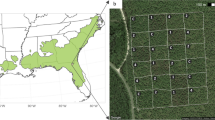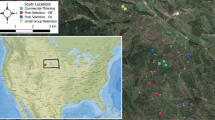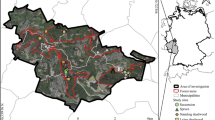Abstract
The objective of this study is to identify easily obtainable predictors for the mean timber stiffness of a forest stand. The most robust predictor is found to be the average taper of the trees in a stand, expressed as the tree height divided by the diameter at breast height (H/D-ratio). In a simple linear regression, the mean H/D-ratio of a stand yielded a R 2-value of 82 % in explaining the mean modulus of elasticity of boards from the corresponding stand. As a practical approach, exclusion of timber from stands with an H\D-ratio under a certain threshold is implemented. This shows an increase of six to ten percentage points in the C30-portion depending on the combinations of strength classes produced with a Dynagrade strength-grading machine. This must be considered a substantial improvement in grade yield and makes such pre-sorting in the forest very attractive since the H/D-ratio can easily be measured in forest inventories or by harvesters.
Zusammenfassung
Ziel dieser Studie ist die Ermittlung leicht bestimmbarer Werte zur Vorhersage der mittleren Steifigkeit aus einem Bestand. Die mittlere Abholzigkeit der Bäume in einem Bestand, angegeben als Baumhöhe geteilt durch den Brusthöhendurchmesser (H/D-Verhältnis), erwies sich als stabilster Vorhersagewert. In einer einfachen linearen Regression zwischen dem mittleren Elastizitätsmodul der Bretter eines entsprechenden Bestandes und dem mittleren H/D-Verhältnis des Bestandes ergab sich ein Bestimmtheitsmaß R² von 82 %. Als ein in der Praxis anwendbares Verfahren wird Holz aus Beständen, bei denen das H/D-Verhältnis einen bestimmten Grenzwert unterschreitet, ausgeschlossen. Dies führt zu einer 6-10 Prozent höheren Ausbeute von Schnittholz in der Festigkeitsklasse C30 je nach gewählter Sortierklassenkombination in einer Dynagrade Sortiermaschine. Dies muss als eine erhebliche Verbesserung der Sortierausbeute erachtet werden und macht eine derartige Vorsortierung im Wald attraktiv, da das H/D-Verhältnis bei Waldbestandsinventuren oder bei der Holzernte leicht gemessen werden kann.


Similar content being viewed by others
References
Amishev D, Murphy GE (2008) In-forest assessment of veneer grade Douglas-fir logs based on acoustic measurement of wood stiffness. For Prod J 58(11):42–47
Amishev D, Murphy GE (2009) Estimating breakeven prices for Douglas-fir veneer quality logs from stiffness graded stands using acoustic tools. For Prod J 59(4):45–52
Auty D, Achim A (2008) The relationship between standing tree acoustic assessment and timber quality in Scots pine and the practical implications for assessing timber quality from naturally regenerated stands. Forestry 81(4):475–487
Brännström M, Oja J, Grönlund A (2007) Predicting board strength by X-ray scanning of logs: the impact of different measurement concepts. Scand J For Res 22(1):60–70
Brazier JD, Mobbs ID (1993) The influence of planting distance on structural wood yields of unthinned sitka spruce. Forestry 66(4):333–352
Carter P, Chauhan S, Walker J (2006) Sorting logs and lumber for stiffness using director HM200. Wood Fiber Sci 38(1):49–54
CEN (2009a) EN 338: structural timber—strength classes. European Committee for Standardization, Brussels
CEN (2009b) EN 14081–4: timber structures—strength graded structural timber with rectangular cross section—part 4: machine grading—grading machine settings for machine controlled systems. European Committee for Standardization, Brussels
CEN (2010) EN 14081–2: timber structures—strength graded structural timber with rectangular cross section—part 2: machine grading; additional requirements for initial type testing. European Committee for Standardization, Brussels
CEN (2011) EN 14081-1: timber structures—strength graded structural timber with rectangular cross section—part 1: general requirements. European Committee for Standardization, Brussels
Chrestin H (2000) Mechanical properties and strength grading of Norway spruce timber of different origins. In: proceedings from the world conference on timber engineering, Whistler Resort, British Columbia, Canada
Clark A, Saucier JR, Baldwin VC, Bower DR (1994) Effect of initial spacing and thinning on lumber grade, yield, and strength of loblolly pine. For Prod J 44(11/12):14–20
Dickson RL, Raymond CA, Joe W, Wilkinson CA (2003) Segregation of Eucalyptus dunnii logs using acoustics. For Ecol Manage 179(1–3):243–251
Dickson RL, Matheson AC, Joe B, Ilic J, Owen JV (2004) Acoustic segregation of Pinus radiata logs for sawmilling. NZ J Forest Sci 34(2):175–189
Edlund J, Lindström H, Nilsson F, Reale M (2006) Modulus of elasticity of Norway spruce saw logs vs structural lumber grade. Holz Roh- Werkst 64(4):273–279
Grabianowski M, Manley B, Walker JCF (2006) Acoustic measurements on standing trees, logs and green lumber. Wood Sci Technol 40(3):205–216
Haartveit EY, Flæte PO (2002) Mechanical properties of Norway spruce lumber from monocultures and mixed stands—modelling bending stiffness and strength using stand and tree characteristics. In: Nepveu G (ed) Connection between silviculture and wood quality: modelling approaches and simulation software, IUFRO WP S5.01-04 workshop. Harrison Hot Springs, British Columbia
Hanhijärvi A, Ranta-Maunus A (2008) Development of strength grading of timber using combined measurement techniques: report of the Combigrade-project—phase 2, vol 686. VTT Publications, Espoo
Hanhijärvi A, Ranta-Maunus A, Turk G (2005) Potential of strength grading of timber with combined measurement techniques: report of the Combigrade-project—phase 1, vol 568. VTT Publications, Espoo
Hoffmeyer P (1995) Styrkesortering ger mervärde, Del 2, Tilgængelig teknik. Laboratoriet for Bygningsmaterialer, Danmarks Tekniske Universitet, Lyngby
Høibø OA (1991) The quality of wood of Norway spruce (Picea abies (L.) Karst) planted with different spacing. Doctoral, Agricultural University of Norway, Ås
Ishiguri F, Matsui R, Iizuka K, Yokota S, Yoshizawa N (2008) Prediction of the mechanical properties of lumber by stress-wave velocity and Pilodyn penetration of 36-year-old Japanese larch trees. Eur J Wood Prod 66(4):275–280
Jang SS (2000) Evaluation of lumber properties by applying stress waves to larch logs grown in Korea. For Prod J 50(3):44–48
Jäppinen A (2000) Automatic sorting of saw logs by grade. Doctoral, Swedish University of Agricultural Sciences, Uppsala
Jäppinen A, Beauregard R (2000) Comparing grade classification criteria for automatic sorting of Norway spruce saw logs. Scand J For Res 15(4):464–471
Johansson K (1992) Effects of initial spacing on the stem and branch properties and graded quality of Picea abies (L.) Karst. Scand J For Res 7(4):503–514
Jones TG, Emms GW (2010) Influence of acoustic velocity, density, and knots on the stiffness grade outturn of radiata pine logs. Wood Fiber Sci 42(1):1–9
Kijidani Y, Hamazuna T, Ito S, Kitahara R, Fukuchi S, Mizoue N, Yoshida S (2010) Effect of height-to-diameter ratio on stem stiffness of sugi (Cryptomeria japonica) cultivars. J Wood Sci 56(1):1–6
Kliger R, Johansson M, Bäckström M (2003) Dynamic measuring of modulus of elasticity—a possible way of sorting logs. Chalmers University of Technology, Gothenburg
Langsethagen KG (2001) Modellering av styrkeegenskaper til trelast fra ensaldretskog av gran (Picea abies (L.) Karst.). Master, Agricultural University of Norway, Ås
Larsson D, Ohlsson S, Perstorper M, Brundin J (1998) Mechanical properties of sawn timber from Norway spruce. Holz Roh- Werkst 56(5):331–338
Lei YC, Zhang SY, Jiang Z (2005) Models for predicting lumber bending MOR and MOE based on tree and stand characteristics in black spruce. Wood Sci Technol 39(1):37–47
Lindstrom H, Harris P, Nakada R (2002) Methods for measuring stiffness of young trees. Holz Roh- Werkst 60(3):165–174
Lindström H, Reale M, Grekin M (2009) Using non-destructive testing to assess modulus of elasticity of Pinus sylvestris trees. Scand J For Res 24:247–257
Liu C, Zhang SY, Cloutier A, Rycabel T (2007a) Modeling lumber bending stiffness and strength in natural black spruce stands using stand and tree chacteristics. For Ecol Manag 242:648–655
Liu C, Zhang SY, Jiang ZH (2007b) Models for predicting lumber grade yield using tree characteristics in black spruce. For Prod J 57(1–2):60–66
Moore J, Achim A, Lyon A, Mochan S, Gardiner B (2009a) Effects of early re-spacing on the physical and mechanical properties of Sitka spruce structural timber. For Ecol Manag 258(7):1174–1180
Moore JR, Lyon AJ, Searles GJ, Vihermaa LE (2009b) The effects of site and stand factors on the tree and wood quality of sitka spruce growing in the United Kingdom. Silva Fenn 43(3):383–396
Oja J, Grundberg S, Grönlund A (2001) Predicting the stiffness of sawn products by X-ray scanning of Norway spruce saw logs. Scand J For Res 16(1):88–96
Oja J, Källsner B, Grundberg S (2005) Predicting the strength of sawn wood products: a comparison between X-ray scanning of logs and machine strength grading of lumber. For Prod J 55(9):55–60
Øvrum A, Høibø OA, Vestøl GI (2009) Grade yield of lumber in Norway spruce (Picea abies (L.) Karst.) as affected by forest quality, tree size and log length. For Prod J 59(6):70–78
Perstorper M (1999) Dynamic testing of logs for predicting of timber strength. Paper presented at the Pacific timber engineering conference, Rotorua
Raymond CA, Joe B, Anderson DW, Watt DJ (2008) Effect of thinning on relationships between three measures of wood stiffness in Pinus radiata: standing trees vs. logs vs. short clear specimens. Can J For Res 38(11):2870–2879
Salas C, Ene L, Gregoire TG, Naesset E, Gobakken T (2010) Modelling tree diameter from airborne laser scanning derived variables: a comparison of spatial statistical models. Remote Sens Environ 114(6):1277–1285
Skyrud REA, Skaug E (2002) Modellering av E-modul, bøyefasthet og densitet hos trelast av gran. Master, Agricultural University of Norway, Ås
Stapel P, Denzler JK (2010) Influence of the origin on specific properties of European spruce and pine. In: Ridley-Ellis D, Moore JR (eds) The future of quality control for wood & wood products, proceedings of the final conference of COST Action E53, Edinburgh
Studsrød CL (2010) MoE, small clear samples vs. utility dimensions for Norway spruce (Picea abies (L.) Karst.). Master, Norwegian University of Life Sciences, Ås
Tsehaye A, Buchanan AH, Walker JCF (2000a) Selecting trees for structural timber. Holz als Roh- und Werkstoff 58(3):162–167
Tsehaye A, Buchanan AH, Walker JCF (2000b) Sorting of logs using acoustics. Wood Sci Technol 34(4):337–344
Tveite B (1971) Site-index curves for Norway Spruce (Picea abies (L.) Karst.), vol 331. Meddelelser Norsk institutt for skogforskning, Ås
Wang XP, Ross RJ, McClellan M, Barbour RJ, Erickson JR, Forsman JW, McGinnis GD (2001) Nondestructive evaluation of standing trees with a stress wave method. Wood Fiber Sci 33(4):522–533
Warren E, Smith RGB, Apiolaza LA, Walker JCF (2009) Effect of stocking on juvenile wood stiffness for three Eucalyptus species. New Forest 37(3):241–250
Zhang S, Chauret G, Ren H, Desjardins R (2002) Impact of initial spacing on plantation black spruce lumber grade yield, bending properties, and msr yield. Wood Fiber Sci 34(3):460–475
Acknowledgments
This study has been financed by the Research Council of Norway in the two projects “SSFF-project” (Grant no. 143920/I30) and “Tresterk” (Grant No. 208085/I10).
Author information
Authors and Affiliations
Corresponding author
Rights and permissions
About this article
Cite this article
Øvrum, A. In-forest assessment of timber stiffness in Norway spruce (Picea abies (L.) Karst.). Eur. J. Wood Prod. 71, 429–435 (2013). https://doi.org/10.1007/s00107-013-0694-3
Received:
Published:
Issue Date:
DOI: https://doi.org/10.1007/s00107-013-0694-3




